
40 minute read
A HOLISTIC APPROACH TO TRAILER TOTAL COST OF OWNERSHIP
Load concentration — or the length of the deck that can handle the weight — varies from one manufacturer to the next. Understanding concentrated load ratings for a particular trailer ensures operators are not overloading the trailer — decreasing safety and efficiency and racking up unnecessary maintenance costs.
Thinking of cost only in terms of purchase price can leave you with a trailer that costs you far more over its lifetime.
With a cost on par with the average U.S. home mortgage, heavy-haul trailers represent a significant investment for businesses. The right trailer can provide fast ROI, greater productivity and increased profits. The wrong decision, however, can leave companies with the financial burden of a unit that will cost far more in the long run than the business is prepared to take on.
Unfortunately, the second scenario is all too common due to an incomplete understanding of total cost of ownership. Purchase price is sometimes the only factor buyers consider when evaluating the cost of a heavy-haul trailer. The initial cost, however, can be misleading when considered alone. A comprehensive approach to calculating total cost of ownership requires an understanding of multiple factors, many of which cannot be found on the price tag.
To the seasoned equipment buyer, price is evaluated based on what the equipment needs to do and the value it adds to the business. Minimizing upfront costs isn’t as important to total cost of ownership as purchasing a trailer that efficiently handles the hauls ahead of it.
That said, there are a few things fleet owners can look at to help determine the best trailer for their needs and minimize long-term expenses.
UNDERSTAND CAPACITY RATINGS
Fleet owners must be sure the heavy-haul trailer they invest in can stand up to expected load capacities. And as experienced fleet managers know, weight capacity ratings only tell part of the story.
The overall weight a trailer can handle is just that, whether it’s a 35-ton or a 50-ton lowbed. However, there is a bit more to consider. Load concentration — or the length of the deck that can handle the weight — varies from one manufacturer to the next. For example, three manufacturers each offer a 26-ft. lowbed that can haul 50 tons, but one may need the entire deck length to safely carry the weight, while another is rated for 50 tons in a 16-ft. span, and another the same weight at half the deck length.
Be sure to understand the difference in ratings. Loads are rarely evenly distributed across the entire deck, so understanding concentrated load ratings for a particular trailer ensures operators are not overloading it — decreasing safety and efficiency and racking up unnecessary maintenance costs.
AXLE CONFIGURATIONS
Laws and regulations vary from state to state, so it’s important to choose a trailer that maximizes the load in each state to minimize permit costs. Work with a manufacturer that understands this and will provide the best possible weight distribution over the axles. This can include adding a fourth flip axle or spreading two or three additional axles apart to evenly accept the load. Choosing axle configurations that offers more flexibility to handle different types of loads increases earning potential over the lifetime of the trailer.
Furthermore, manufacturers often interpret Gross Vehicle Weight Rating (GVWR) and Gross Axle Weight Rating (GAWR) differently. Misunderstandings could lead to limited ratings and configurations, which could affect all that is needed to get the job done.
ENGINEERING AND SAFETY RATING
Well thought out features and designs are a good indication of experienced engineering at work. This goes beyond steel, welding and bolts. Good engineering is about understanding each customer’s needs and building a trailer optimized for durability, longevity and minimal maintenance. Working with a manufacturer that can provide custom-built solutions is ideal. They can design a trailer that can handle the load, which minimizes maintenance and ensures owners get the greatest longevity.
The trailer’s safety rating is one of the quickest ways to determine if a manufacturer uses high-quality components — such as heavy-duty T-1 steel and Apitong flooring — that will stand up to the jobs you have planned. The safety rating is intended to show operators how well the trailer is equipped to deal with the extra stress that comes from things like bumps, chuckholes and railroad tracks as it travels down the road.
These bumps in the road cause the trailer to experience a momentary magnification of payload. In general, trailers can expect an average magnification of payload ratio 1.8 to 1. This means a 50-ton-rated trailer with a 50-ton load will experience 1.8 times the stress, or 90 tons, as it travels over inconsistencies in the road.
Safety ratings tell the end user how much magnification of payload the trailer is designed to withstand. Safety ratings will range from no margin to up to 2.5 to 1, an industry high. A trailer with a high safety rating and built with high-quality materials may cost more up front but will better stand up to the dayto-day stresses of hauling loads.
Drivers should keep in mind that though the average magnification of payload is 1.8, in many instances the trailer will experience much more than that. A trailer designed with extra margin in the safety rating will experience less stress, wear and damage, resulting in reduced maintenance costs over time.
Heavy-haul trailers built with lower-quality materials offer a lower safety rating so they simply can’t provide that kind of longevity. As a result, the trailers are more prone to premature damage and require more maintenance, resulting in less time working and a lower return over the life of the trailer.
LONG MAINTENANCE INTERVALS

The ease and cost of maintenance contribute greatly to the lifetime cost of ownership of heavy-haul trailers. A welldesigned trailer will provide long maintenance intervals and be easy to work on when maintenance is necessary. A good manufacturer will also focus on ensuring wear parts are readily available at a reasonable cost.
Some of the most critical elements of a maintenance-friendly trailer are the quality of the removable gooseneck, suspension system and components like steel and paint.
Removable Gooseneck: The removable gooseneck revolutionized heavy haul, increasing safety and productivity on jobsites around the world. Since then, improvements such as hydraulics have further increased overall efficiency.
In addition to profile and liftability, ease of use should be considered when selecting a removable gooseneck for optimum ROI. Industry-leading manufacturers offer hydraulic removable gooseneck systems that operate at 5 to 15 gpm, making them less susceptible to leaks. These low-pressure systems also use hoses that are readily available and more cost efficient than those needed for high-pressure systems.
The location of the hydraulic system on the gooseneck can further increase ease of maintenance. Mounting the system within the gooseneck base section limits vibration and damage, increasing the length of maintenance intervals.
Suspension Systems: All things being equal, a trailer with a properly spec’d suspension system experiences less wear and tear. A maintenance-friendly suspension system offers features designed specifically to increase its resilience and lifespan, as well as simplify the maintenance process when things do break down. Two easy things to look for are clamp-in bushings and contoured axle seats.
Solid clamp-in bushings offer an extended life over slotted designs and easy replacement that doesn’t require an expensive press. The ease of replacement eliminates the need to haul the trailer to a commercial shop and greatly reduces the cost.
Extra-long, contoured axle seats are another indicator of a low-maintenance suspension system. Engineering axle seats with a contour in the middle reduces stress on the weld, reducing the likelihood of costly breaks. The extra length and contour design also provide a strong connection without the need of added U-bolts, reducing the total weight of the system and the added maintenance costs that go with it.
Steel and Paint: Fleet owners should keep wear components in mind when deciding which unit will best meet the needs of their operation. High-quality materials and finishes will last longer than traditional paints and lower-cost alternatives, a critical boost in longevity for fleet managers that need their trailers to stand up to challenging conditions.
For must-hold-up situations, choose a trailer built with high-strength steel, such as 12-inch-deep I-beams with a minimum yield strength of 100,000 psi. This, along with premium primer and topcoat finishes, will ensure long-term durability.
Ease of Maintenance: Some manufacturers design their trailers with maintenance points that are fast and easy to access, which is important for minimizing the time and money spent maintaining the unit. For example, cylinders that are mounted parallel to the ground allow technicians to simply remove four bolts and unpin the cylinder for replacement. This takes a matter of minutes, compared to as many as eight hours replacing vertically mounted cylinders.
Cylinder replacement varies based on road conditions, load distribution and other factors unique to each trailer and operator. In general, replacing parallel cylinders saves a significant amount of time and effort over the life of the trailer. Even if required cylinder replacement is minimal, over the trailer’s lifetime, it demonstrates how ease of maintenance proves itself as a vital variable in the total cost of ownership formula.
RESALE VALUE
The last thing to keep in mind when considering how much a trailer will cost over its lifetime is how much money it will be worth when it comes time to sell. At the time of resale, the decision to buy a trailer with high-quality components really pays off. Often, to know the true quality of a trailer, you can look at the value at auction.
In conjunction with a proactive preventive maintenance program, a high-quality trailer from a reputable manufacturer may provide more than 30 years of useful life. This longevity results in sought-after resale units that fetch a higher price at auction than lower-quality trailers that are showing their age. It should be considered as part of a comprehensive evaluation of total cost of ownership.
So, while the number on the price tag is important, it only takes you so far. Heavy-haul trailers travel thousands of miles over their lifetimes — and a lot can happen between Point A and B. To truly understand total cost of ownership, business owners and operators must have a comprehensive understanding of what their trailer will cost in its lifetime. Considering these postpurchase costs before making a decision will help ensure trailer lifetime costs do not undermine any savings that were enjoyed at the moment of purchase. A wellresearched trailer investment can provide fast ROI and reliability that goes on for miles. ET
Troy Geisler is the vice president of sales and marketing for Talbert Manufacturing.
Purchase price is sometimes the only factor buyers consider when evaluating the cost of a heavy-haul trailer, but it can be misleading when considered alone. A comprehensive approach to calculating total cost of ownership requires an understanding of multiple factors, many of which cannot be found on the price tag.
Tailgates Put More in the Bed and More Dollars to the BOTTOM LINE
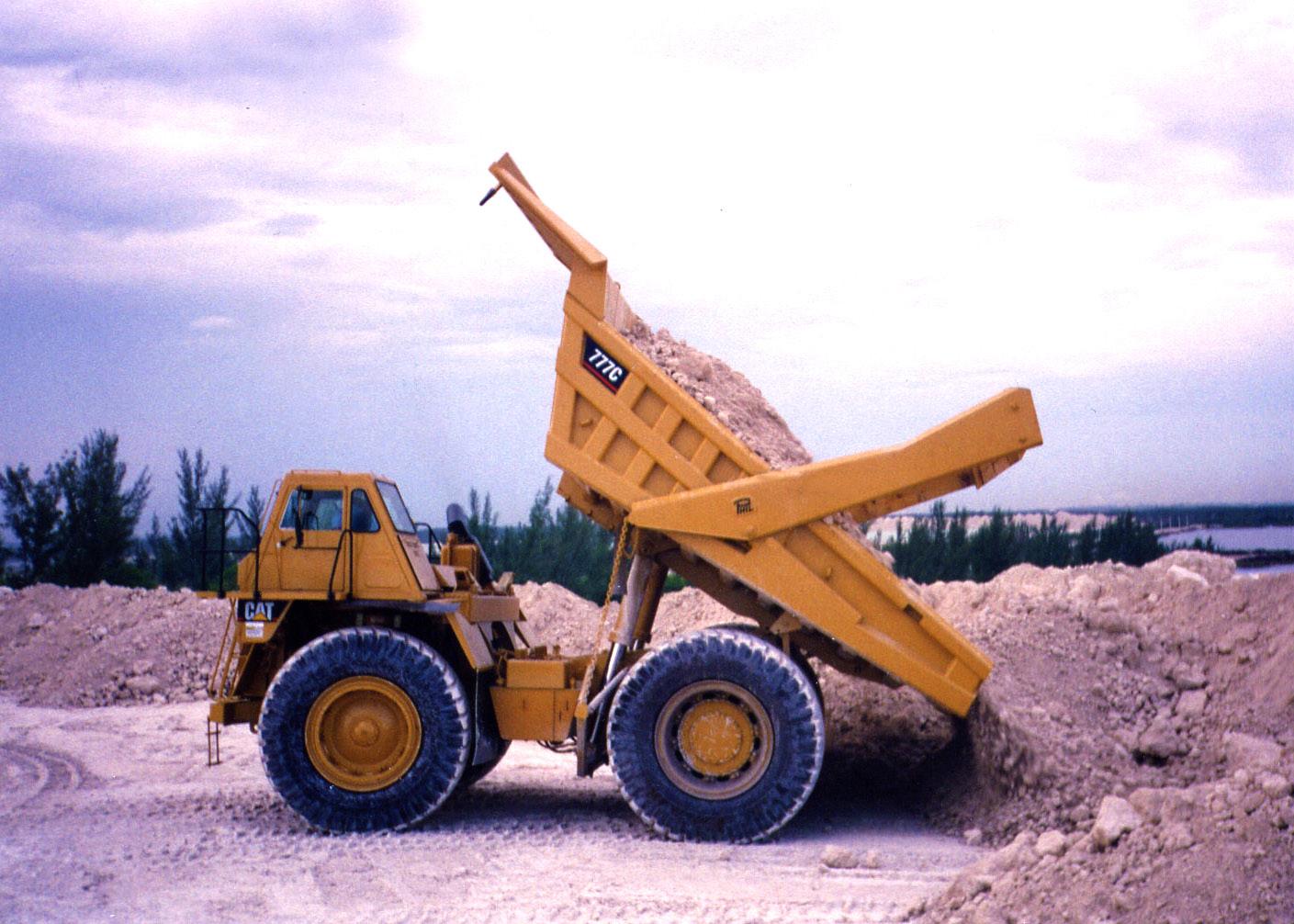
It’s important to find a tailgate that lifts high enough to avoid damage and carryback.
Tailgates with durable components, such as steel alloy chains, last longer and perform better.
Most haul trucks come standard without a tailgate. While it might seem like a small feature, not having a tailgate often results in loads that are typically 10% to 15% below rated capacity. Though not intentional, loading a unit without a tailgate results in less material on the truck to prevent the inherent spillage out the back and over the side. Sacrificing 15% per load each trip is simply not affordable. It costs relatively the same amount of money in labor, fuel and wear on a truck to haul a half full load as it does a load filled to capacity. By allowing for volume increases to meet the truck’s rated capacity, tailgates quickly and easily boost an operation’s profitability. For example, a 70-ton-capacity truck with a tailgate hauls nearly 11 more tons per load than a 70-ton truck without a tailgate. If a fleet of six trucks adds 11 tons to each of their respective 12 loads per day, an additional 792 tons is hauled daily. That equates to nearly $7,049 in profits if hauling aggregates at an average of $8.90 per ton. It’s like adding another truck to your fleet without the increase in fuel, maintenance or labor.
Capacity is only part of the equation. Tailgates not only allow for maximum payload but also provide the loader operator with a better, larger loading target, which enhances speed and efficiency while reducing wear and stress on the truck. Tailgates optimize the loading zone by providing a better target so loaders can dump materials in the middle of the body, rather than near the front, improving weight distribution and overall truck stability. Without the added benefit of the tailgate, loader operators avoid spillage by placing most or all of the materials toward the front of the bed. This loading technique ends up overloading and stressing the front axles and hydraulic hoist cylinders of the truck, resulting in premature tire wear, body maintenance, and potential axle and hoist cylinder damage.
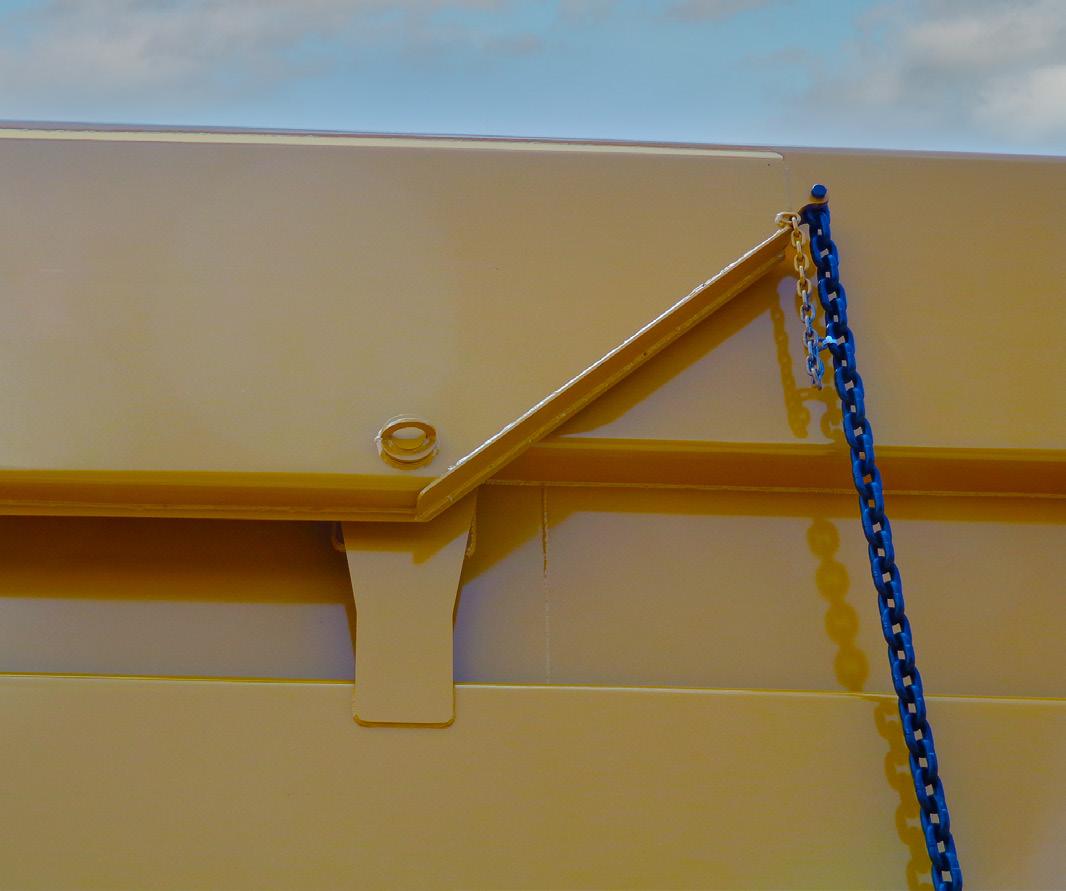
MINIMIZE MAINTENANCE
For example, rigid-frame haul trucks are typically designed to carry one-third of the loaded weight on their front axle and two-thirds on the back. Dumping heavy materials toward the front puts immoderate stress on the chassis, axles, front tires, suspensions and hydraulic systems.
Front tires only support so much weight before they blow or rim damage occurs. Sometimes tires can be salvaged, patched or re-treaded, but even repairs are expensive, costing up to 60% of their original cost. An optimized loading target, equalized weight distribution and reduced spillage means that trucks with tailgates can extend a tire’s service life by as much as 40% or up to 13,000 hours in some cases.
But it’s important to remember that just because a truck has a tailgate, that doesn’t mean it can be overloaded. A 70-ton truck cannot haul 80 tons of material without operating outside of the OEM truck manufacturers guidelines; this can cause damage and safety hazards in addition to voiding the truck warranty. Squeezing an extra 10 tons in a load might seem like a quick way to bring in extra profits; however, repair costs far exceed the additional revenue if you blow a tire or cripple the chassis and axles.
The benefits of adding a tailgate extend beyond the truck to haul roads and the other equipment working in proximity. Haul roads are often narrow, rough and littered with spillage, which makes them hard to navigate and poses risks to the trucks and other equipment operating at the site. All options for
All photos courtesy Philippi-Hagenbuch A tailgate optimizes the loading target and equalizes weight distribution while reducing the risk of damage to a truck’s frame and suspension system.
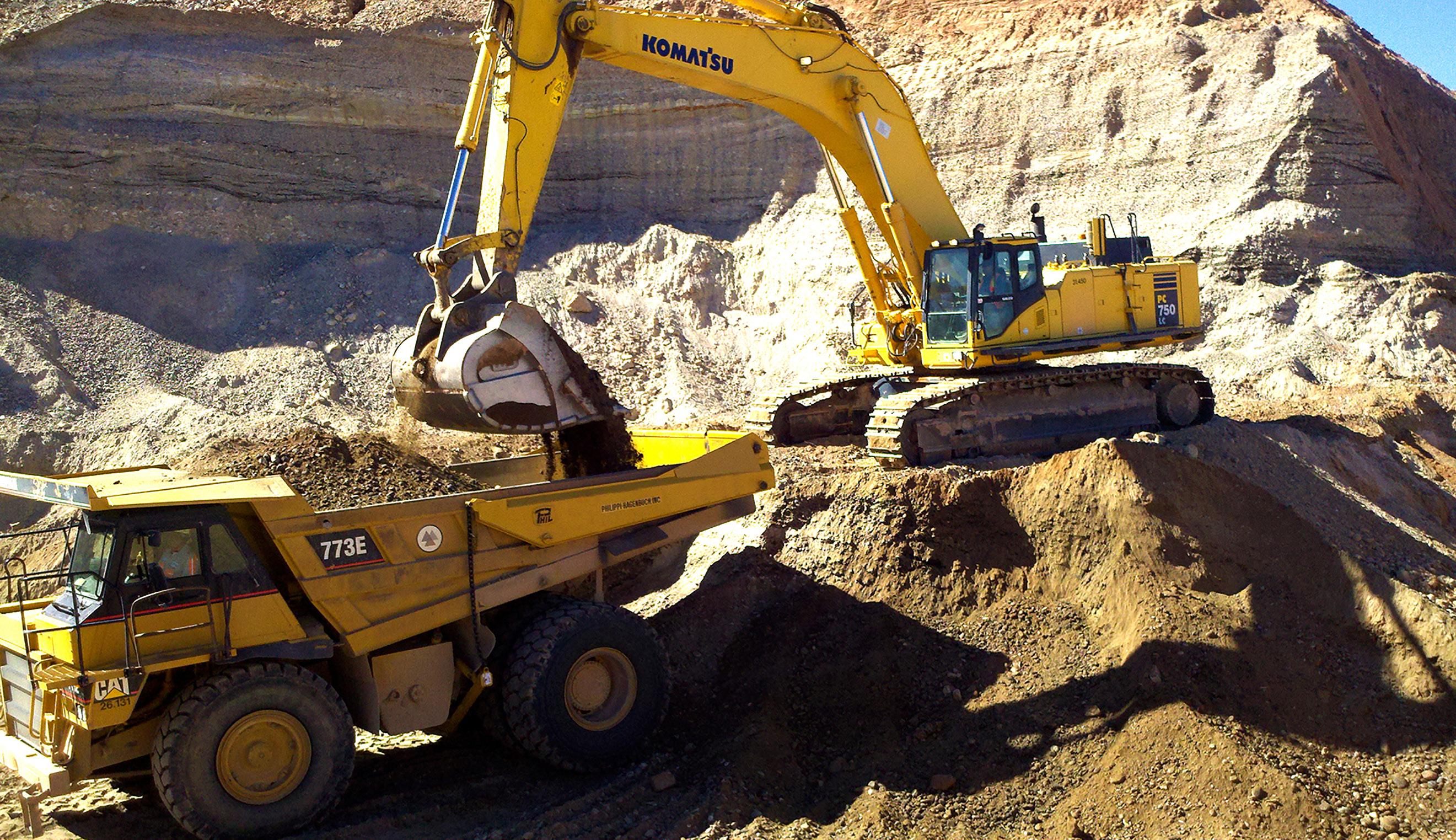
dealing with the challenges result in lost time or increased expenses. Closing haul roads to clear the debris means lost productivity and the costs associated with the fuel and labor and downtime for cleaning.
Navigating the debris can damage tires as well as a truck’s suspension systems. In some large mines, for example, more than 200 tires are replaced per month because of debris damage or overloading. Many businesses aren’t equipped to handle the type of negative impact tire damage can have on overall profitability, especially since the cost of rubber has gone up by 250% since 2009.
WHAT OPTIONS ARE THERE?
It doesn’t take long to put pencil to paper and figure out that adding a tailgate enhances profitability, but the decision is not that simple. With a variety of tailgate options on the market, it’s important to find the design that complements the specific operation.
A tailgate enhances operations whether you’re hauling aggregates, coal, iron, fly ash, oil sands or soupy, viscous materials. But there are a couple of design aspects to look for before making a purchase decision, such as durability and versatility.
First and foremost, work with a manufacturer that makes a customizable tailgate for any truck body. Then, find a tailgate that lifts instead of drops down for maximum efficiency. A dropdown tailgate is sometimes slower when opening and closing and is more susceptible to damage from the dumped materials. These designs often rely on pins or hydraulic systems, and when there are more grease points, cylinders and joints, the risk of failure increases. They might seem like quick, economical solutions, but dropdown tailgates end up costing more for repairs and replacement in the long run.
Ultimately, a lifting, scissorstyle tailgate has fewer moving parts so there’s less potential maintenance. But having fewer moving parts isn’t everything. Be sure these few parts are tough enough for the job. A tailgate won’t last long if it can’t withstand the breadth of material being hauled. Find a tailgate that’s built with durable materials, such as high-strength steel, and features strong components including steel alloy chains and bushings that don’t require ongoing lubrication.
Customizations to tailgates are also a way to tie them into the truck fleet methodology employed at any given site. Truck bodies frequently have sideboards that add height onto the sides for either added volumetric capacity or to keep material within the bed. In this case, having the tailgate built up to the height of the sideboards creates a unified height around the entire bed, as opposed to a high-sided body with a low-sided tailgate.
Adding cushion pads to a tailgate will soften the blow when it is raised and lowered in harsh worksite conditions. When operations have extremely bouncy haul roads, the cushion pads minimize noise and increase the service life of the tailgate and other truck components.
Operations that haul large amounts of wet material arguably need a tailgate more than any other operation that uses offhighway haul trucks. In these applications, a tailgate with a fluidic seal can create a near-perfect seal, resulting in minimal fluid leakage during transport. While it is impossible to contain 100% of the liquid material, it is not uncommon to decrease wet material spillage by up to 99.5% when a truly engineered solution is implemented.
Lastly, make sure the tailgate lifts high and fast enough to get out of the way before unloading. The last thing you want is the tailgate to hold back the load during dumping rather than allowing it to flow freely out of the back of the truck body. Fast dumps lead to increased efficiency and productivity. Materials left behind in the bed or stuck in grease points damage hinges and overall structure, and the amount of carryback reduces the volume of the next load. ROI AND BEYOND
The return on investment associated with a tailgate is significant, and scissor-style tailgates take it even further. From increased volume and reduced maintenance to fast load dumping and safe operations, an off-highway tailgate quickly pays for itself, even with the average cost between $18,000 to $28,000, based on the size of haul truck and options chosen.
Consider that six 70-toncapacity trucks hauling aggregates bringing in approximately $7,490 in additional profits per day will start seeing an ROI on the purchase of the six tailgates after 22 days from the volume boost alone, not to mention the additional fuel and tire cost savings associated with the addition of tailgates to a truck fleet.
And when it comes to profits, who doesn’t want more? ET
Josh Swank is vice president of sales and marketing, PhilippiHagenbuch, Inc.
Four of the five trucks for SMUD are being upfit with truck bodies from Knapheide Manufacturing Co.
California Utility Service Company to Put ALL-ELECTRIC Trucks to Work

First production Zeus Class 5 electric work trucks are being built to spec and put to the test by the Sacramento Municipal Utility District.
Paul Lau, CEO and general manager of the Sacramento Municipal Utility District (SMUD),
believes electrifying the transportation and building sector “is a cornerstone of a strategy to get to zero carbon” due to the relatively large emissions generated by those industries. For its part, SMUD, the sixth largest community-owned, not-for-profit electric service company in the U.S., has set a goal of removing all carbon emissions from its power supply by 2030.
“It’s the most aggressive carbon reduction goal of any larger utility in the United States,” Lau asserts. To meet its objective of 100% zero-emissions vehicles and equipment by 2030, SMUD has been progressively electrifying its fleet of more than 1,000 transportation assets. “We’ve made good progress on some fronts,” says Lau. “For example, we removed the last gasoline-only sedans from our fleet in 2019.
“But it’s been more challenging with larger medium- and heavy-duty trucks because the electric options are limited,” he continues. “That’s why the Zeus vehicles are so exciting.”
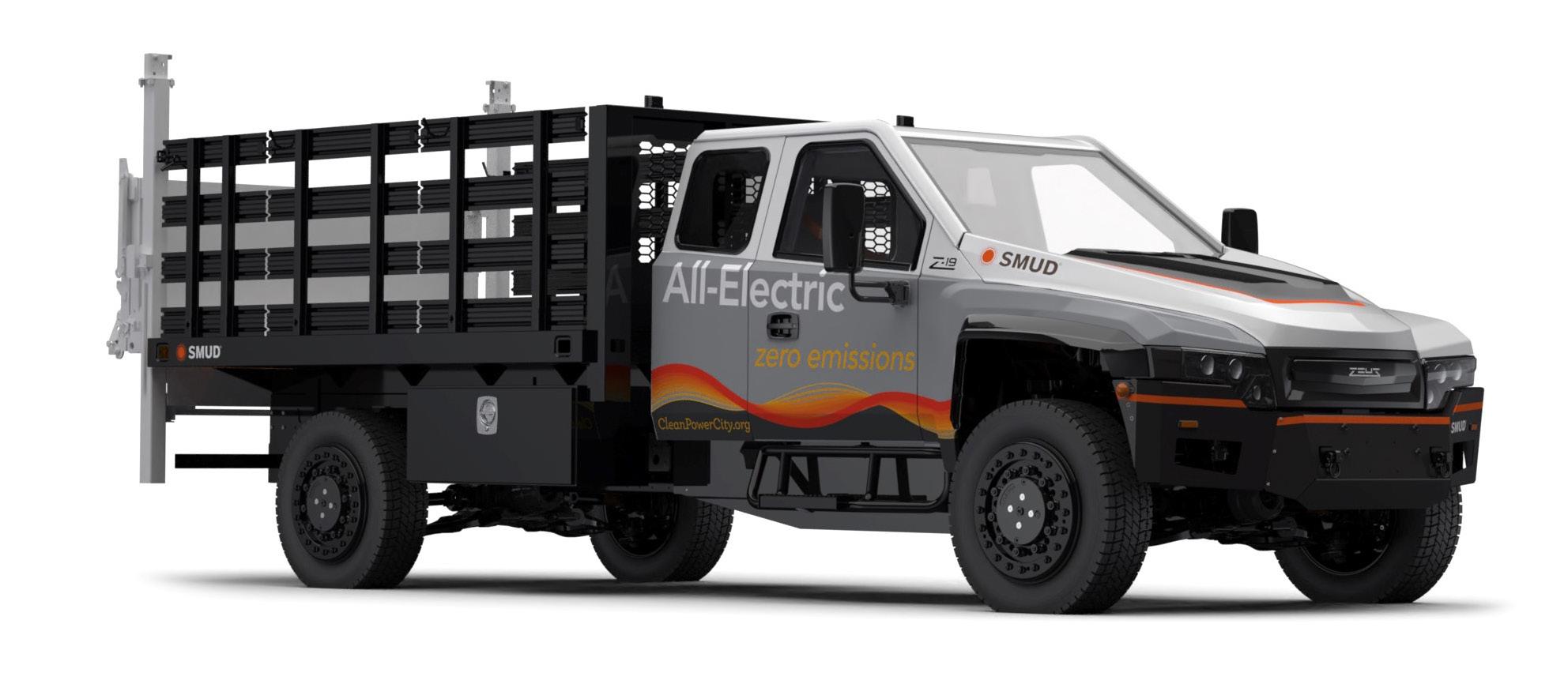
The first production Zeus electric work trucks are being built to spec for SMUD. Four of the trucks are being upfit with truck bodies from the Knapheide, including an electric stake truck. ZEUS ELECTRIFIES WORK TRUCK APPLICATIONS
Zeus Electric Chassis, Inc. has developed a versatile batteryelectric vehicle cab and chassis platform that enables fleets to use existing OEM body partners, system integrators and upfitters to adapt the vehicle to various Class 4, 5 and 6 applications, such as bucket trucks, cranes, dump bodies, service bodies and more.
According to the company’s website, currently available chassis models offer from 290- to 510-hp ratings and from 2,040 to 3,500 lbs.-ft. of torque. GVWRs range from 16,0001 to 26,000 lbs. with payloads from 8,000 up to 13,000 lbs. All models utilize lithium-ion NMC batteries as the primary power source.
Armed with the desire to shrink its carbon footprint in the larger vehicle size classes, SMUD will become Zeus Electric Chassis’ first customer. “Our purchase of five Zeus vehicles removed five medium-duty diesel trucks from the road, along with their associated emissions,” Lau states. “SMUD would help demonstrate to California and national commercial fleet
operators that electrification is possible for medium-duty or Class 4 and 5 work trucks, which is the core of commercial and construction fleets.”
The first production Zeus Class 5 electric work trucks are being built to spec for SMUD, with four of the trucks being upfit with truck bodies from the Knapheide Manufacturing Co. Configurations will include an electric stake truck, electric open-body service truck, electric closed-body service truck with crew cab and an electric dump truck.
A configuration of the electric stake truck was unveiled to Knapheide dealers and distributors at a special event during Work Truck Week in Indianapolis on March 8, and from there, was shipped to Sacramento for a ceremonial presentation of the key fob to SMUD at an event hosted by the California Mobility Center (CMC). The first of the five production trucks ordered by SMUD, the dump body, will be shown at the ACT Expo in May prior to being put into service in the field.
ENSURING THE BEST UPFIT SOLUTIONS
Effectively marrying a truck body and chassis is essential to the success of any vehicle upfit. That’s why Zeus chose to bring body OEM Knapheide into its chassis design development early on – to ensure the focus was kept on meeting customer needs.
“Other EV companies are either not knowledgeable about commercial applications, or they’re intensely focused on a certain application, like lastmile delivery,” said Chris Weiss, vice president of engineering at Knapheide. “Either way they don’t understand the complexity of the commercial market, both in terms of channel-to-market and design constraints. And they are struggling with it.
“The best upfit solutions start with a conversation,” he continues. “To make fleets more productive, we need to understand what our customer wants to do, and tailor our solution to meet their needs.”
The truck bodies for SMUD’s Zeus vehicles are built at Knapheide’s Quincy, IL manufacturing facility, procured through Custom Truck One Source (CTOS) and delivered to the Zeus facility for installation. Holistic integration of the truck body with the configurable chassis is one of the key differentiators for the Zeus Power Platform.
The traditional channel-tomarket process for work trucks can take four to five months of cut-and-paste to integrate the truck body and chassis. The chassis design of the Zeus Power Platform keeps the battery within the frame rails and incorporates pre-engineered system solutions that make the upfit installation cleaner, quicker and safer. This is particularly important with an electric vehicle given the high-voltage lines that connect the chassis power to the body.
The ability to tailor to customer requirements is essential. “As our customers explore the opportunities with electric upfits, we need to define up-front their power needs via work and range,” Weiss comments. “The electric chassis is a great solution overall as it provides the power source for all the electric truck equipment. With the unique approach of the Zeus design, if more power is needed, more battery capacity can be incorporated into the chassis to meet the customer’s needs.”
The integration between the Zeus Power Platform and Knapheide truck bodies has proven a productive pairing. “It’s important for Zeus to demonstrate to our customer that they can continue to get the same tried-and-true truck body on our electric chassis as they are accustomed to having,” says Bob Grinstead, founder and CEO for Zeus. “Working with Knapheide and CTOS on these initial truck deliveries allows us to do just that.”

NEXT STEP TOWARD VALIDATION
The next step in the process is ensuring the EVs can fulfill that expectation in the field. As a founding member of the CMC, a public/private partnership to support, fund and commercialize new EV technologies, SMUD has been able to work with Zeus to customize the vehicles to its specific needs and road test them in its utility operations.
“The CMC helps connect startups like Zeus with potential clients like SMUD to test the technology in commercial tests in various industries,” Lau explains. “We’re very excited to take delivery of five vehicles in the second quarter of 2022 and test them in several applications across our business.”
The trucks will be put into service with five different crews to validate the technology and create a Class 5 electric vehicle truck fleet adoption process for the future. “We’ll use them in a variety of applications from facilities management to our line asset groups to substation work. The Zeus trucks will replace existing equipment, so we’ll see how [much] carbon emissions saving from day one,” says Lau. He is optimistic that the trucks will not just match, but outperform their gasoline counterparts.
Operation of the vehicles will be documented every step of the way. “Our development team will be collecting data from the onboard GPS and telematics systems for real-time diagnostic analytics of duty cycles, charging patterns,” says Lau. “[We] will incorporate feedback from the operations on a weekly basis, which we will also share with Zeus along the way.” ET
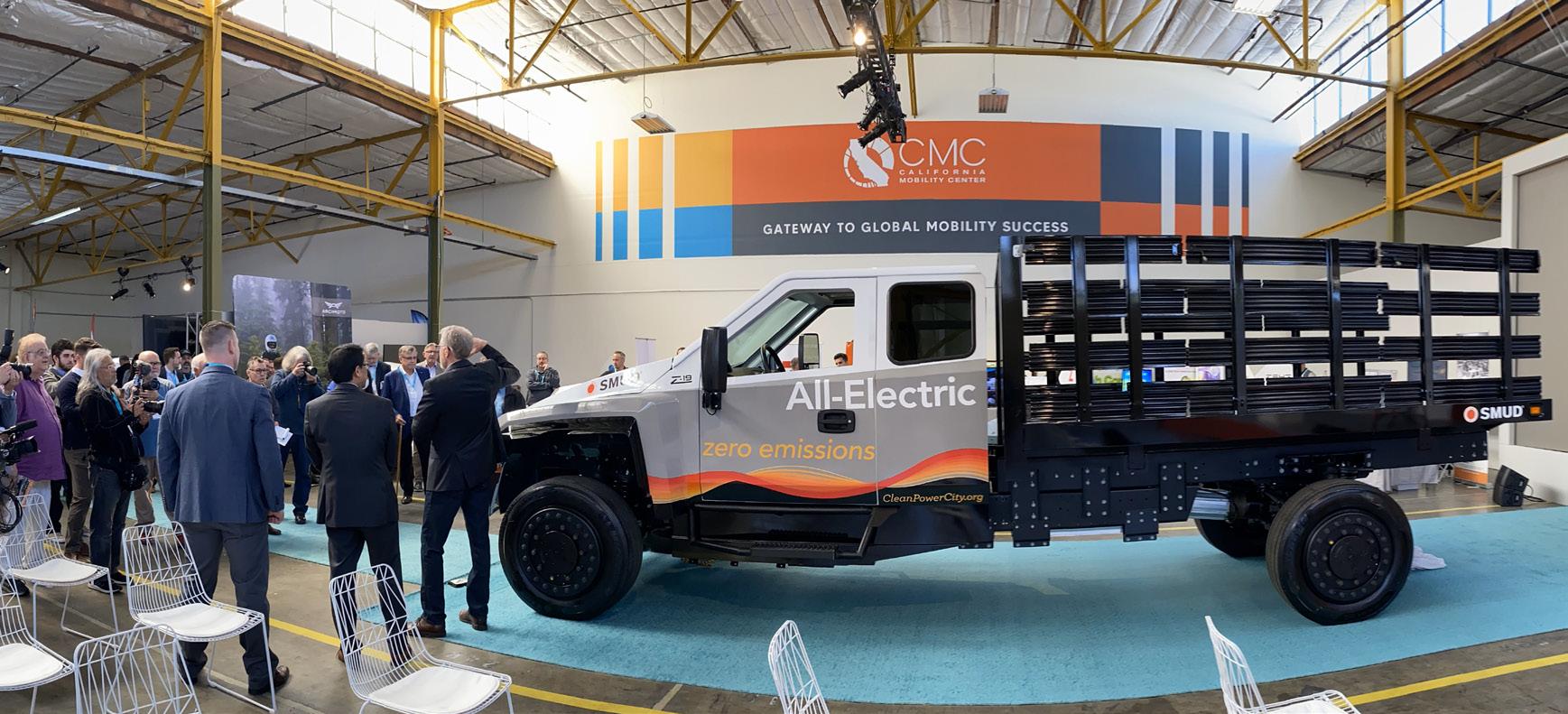
Editor’s note: Quotes from Paul Lau, Sacramento Municipal Utility District (SMUD), excerpted from a transcript of the following video by Zeus Electric Chassis, Inc.
The California Mobility Center is a public/private partnership to support, fund and commercialize new EV technologies. It helps connect startups like Zeus with potential clients to test the technology in commercial tests in various industries.
The SMUD vehicles in production at Zeus’ production facility in January 2022.
XL Low-profile HDG Trailer
The Low-profile Hydraulic Detachable Gooseneck (HDG) trailer has a 110,000lb. capacity in 12 ft., an overall length of 53 ft. and overall width of 8.5 ft.
•Includes a 26-ft.-long main deck with a loaded deck height of 24 in. and an 8-in. ground clearance and 14-ft.-long rear deck with a 40-in. loaded deck height •Tapered front beams offer an extremely low load angle of only 4° and 42-in. flip ramps provide extra loading assistance •13-ft. gooseneck has a swing clearance of 110 in., a relief cut-out for added space between the truck and trailer and a sloped nose to protect the air and electric connections from damage •Five-position ride height allows the deck to be leveled as needed based on neck position and load Read more at: https://myfc.pro/feabx8

Eager Beaver 50 GSL-PT Paver Trailer
The 50 GSL-PT has a 100,000lb. load capacity and 122,700-lb. GVWR and is suited for loading rollers, pavers and milling machines.
•Tapered four-beam, 16-in.-deep cambered I-beam mainframe and side rails •10-in.-deep crossmembers pierced through the mainframe •25,000-lb. axles with all-wheel ABS (4S3M) with spring brakes on all axles •Cush Air Ride suspension with 75,000-lb.-capacity, air lift third axle Read more at: https://myfc.pro/2kjwc7
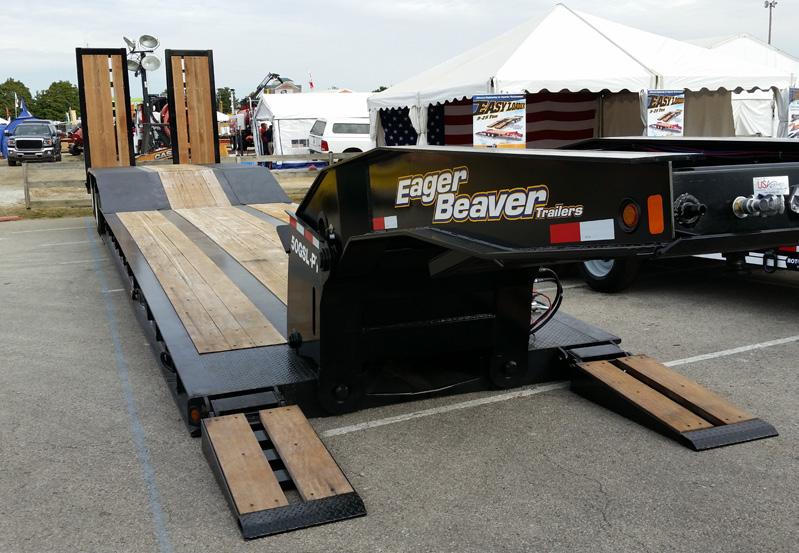
Advance Metalworking Lo Riser Inclining Platform Trailer
The Lo Riser uses hydraulics to lower the deck to ground height to provide easy drive-on access.
•6,000-, 10,000-, 12,000-, 14,000- and 16,000-lb. load capacities in two-wheel or four-wheel configurations •High strength, low alloy steel construction •Minimum 4° angle when lowered •Include six D-ring tie-downs and built-in tie-down rails •Breakaway kit with chains, a load check safety system and electric brakes on both axles provide added security •Combination of hydraulics over rubber suspension provides smooth travel even when empty Read more at: https://myfc.pro/k3crbe

Talbert Tag-A-Long AC Series
The 10- to 25-ton Tag-A-Long Austin Carry-All Series (AC Series) trailers feature loaded deck heights, durable construction and a low, 7° load angle to transport small- to mid-size equipment.
•Dual-axle AC-10 offers a 10-ton, 20,000-lb. capacity, 24-ft. deck length, 5-ft. 5-in. self-cleaning, spring-assisted rear ramps and 32.25-in. loaded deck height •AC-20 provides a 20-ton, 40,000-lb. capacity within the same deck dimension and loaded deck height •AC3-25 has a 29-ft. deck and a 25-ton, 50,000- lb. capacity with a 32.75-in. loaded deck height •AC-20ART and AC3-25ART include an air ramp and/or air tilt for loading of lowclearance equipment Read more at: https://myfc.pro/4ztgjj
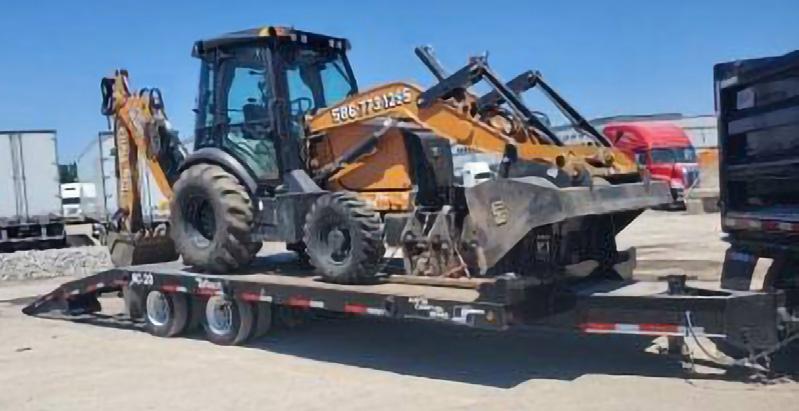
Towmaster T-24TA AirTilt Bed Trailer
The T-24TA deck-over air-tilt trailer offers convenience and easy loading by tilting the bed using air from the tow vehicle’s system.
•Features an angled beavertail and ramps to offer a low loading angle suited for small-wheeled or paver equipment •Ramps can be manual or air operated •Features a single-lever twin-latch system to secure the deck to the frame •2-in. nominal white oak wood deck with a 34-in. height (empty) and 8-ft. 6-in. width •Includes air brakes, a dual air bag design, Hutchens adjustable suspension and LED lights and sealed wiring Read more at: https://myfc.pro/2uhvzk

Felling Updated Air Tilt Product Line
The Air Tilt model has undergone design modifications to increase operator ease of use and safety, including extension of the fixed approach ramp from 14 to 22 in. in length.
•Load angle reduced by approximately 10° for a better load angle with a more subtle break-over point •Six models available with payload capacities ranging from 19,700 to 50,000 lbs. •Two airbags (four optional) powered from the tow vehicle tilt the trailer and keep the deck in place for loading/unloading •Optional ramps and full-size oval recessed strobe lights Read more at: https://myfc.pro/daw4u2

Fontaine Magnitude 60HD Lowbed Trailer
The Magnitude 60HD modular lowbed trailer hauls 60 tons in 16 ft. utilizing the EQ2 Spreader and two additional axles (3+2 configuration).
•Can handle 65 tons in 12 ft. without adding a flip box or a spreader •Modular tridem bogie can connect with four different deck options including a flat level, drop side rail, beam deck or extendable deck •Fabricated with 100,000-lb. minimum yield steel flanges •Standard configuration boasts a 26-ft. clear deck length and loaded deck height for the flat level deck of 22 in. with 6 in. of ground clearance •Both flat level and drop side rail decks available in optional 9-ft. width along with 5- or 10-ft. deck inserts Read more at: https://myfc.pro/xg8ms9

“INFRASTRUCTURE DECADE” Won’t Happen Without Construction Pros
During his State of the Union address in March, President Biden announced an ambitious list of projects to repair U.S. infrastructure and set the stage for the country to enter an “infrastructure decade.” These projects – installing 500,000 electric vehicle charging stations, fixing over 65,000 miles of highway and repairing 1,500 bridges – have the potential to create millions of jobs, contribute to economic equity and help insulate Americans from the effects of climate change.
The work is critically needed and long overdue, both here in the United States and abroad. According to McKinsey, a $3.5 trillion investment in global economic infrastructure is required per year through 2035 to keep up with the demand for water, roads, airports, ports, electrical grids and communication networks.
Meeting the global demand for infrastructure transformation is a daunting challenge, but construction professionals worldwide are up to the task. To be successful, construction leaders must work together to overcome the industry-wide propensity to underprice projects, which often leads to scope creep. A McKinsey report from 2020 found construction projects typically take 20% longer to finish than scheduled and are up to 80% over budget. Our own research found that two in five (40%) construction-related projects exceed their original timelines, and nearly three-quarters (73%) end over budget.
The world relies on the next generation of construction professionals and organizations more than ever before. To lead local, national and global transformation efforts, the construction industry, and its professionals, need to transform, as well. Here’s how it can be done:

ENCOURAGE YOUNG PEOPLE TO CONSIDER CONSTRUCTION CAREERS
As news headlines and job reports have reminded us over the past year, skilled labor shortages have become a major issue in many industries, and construction is no exception. Over the coming decade, a surge in retirements will further drain talent.
According to the National Center for Construction Education and Research, more than 40% of the current U.S. construction workforce
is expected to retire by 2031 (https://bit.ly/3JFshGI). Our research predicts more than 61 million project managers will be needed in the manufacturing and construction industries by 2030 – a 13% increase over 2019 (https://bit.ly/3LiXQ9Y).
I believe more Millennials and Gen Xers would consider careers in construction if they understood the breadth of different roles, skill sets and opportunities for growth available within the industry. Yes, it’s true construction is among the least digitized industries globally and has shied away from innovation due to limited margins and general risk aversion. But that’s changing. As more construction organizations experiment with artificial intelligence, drones and other forms of robotics, young people may recognize holding a highly sought-after job in technology doesn’t necessarily mean working for a “tech company.”
ENSURE CONSTRUCTION PROS HAVE THE RIGHT SKILLS
As the construction industry modernizes, organizations and the individuals who work for them must invest in upskilling to ensure they have the skills necessary to bring this infrastructure behemoth to fruition.
What are those skills? Today, a construction professional needs a combination of business acumen, technical abilities to keep up with the digitization of the industry, and interpersonal skills to ensure the work is done accurately and safely. And because delivering on this infrastructure investment will likely take an entire decade – if not longer – the construction professionals we are relying on must be committed to lifelong learning so they can stay up to date as the industry continues to evolve.
Fortunately, many resources are available to industry professionals looking to gain the skills necessary to “future-proof” their careers. For example, my organization, the Project Management Institute, offers The Construction Professional in Built Environment Projects (https://bit.ly/3IHL4zX), a full certification for project professionals in construction. The certification is designed for industry professionals to learn and prove mastery of the skills and knowledge needed to bring large, complex projects to life and transform the global construction industry.
PUT PROJECT MANAGERS IN THE DRIVER’S SEAT
Every industry relies on project managers to break down bold, ambitious ideas into manageable tasks and monitor progress. Completing projects on time and within budget is nearly always a challenge. This is particularly crucial performing in the public sector, as project managers play a pivotal role in efficiently tracking taxpayerfunded resources and delivering project outcomes for governments around the world.
Project management is about more than box-checking and note-taking. The most highly skilled project managers are agile problem-solvers, adept at building relationships and flexible enough to pivot as needed throughout a project’s life cycle. In construction, project managers understand the key causes of scope creep and know how to hedge against them. As labor shortages, climate change and inflation continue to impact construction projects, project managers will be more critical than ever in keeping them on track.
The 2020s can be an “infrastructure decade” – but only if we have the right people to bring these projects to fruition. Rebuilding American infrastructure will require onboarding millions of new construction workers and equipping them with the skills they need to be successful. Project management professionals will be important in ensuring this work is completed accurately, resulting in a crucial transformation for the livelihood of millions of people.
Finally, infrastructure projects that land on time and budget will ensure maximum return on the significant investments now authorized under the IIJA bill. If we’re willing to make them, the return on these investments will be immense – as is the risk we take if we delay this critical work. ET
Brantlee Underhill is managing director, North America, for the Project Management Institute (PMI).
WHAT’S ONLINE?
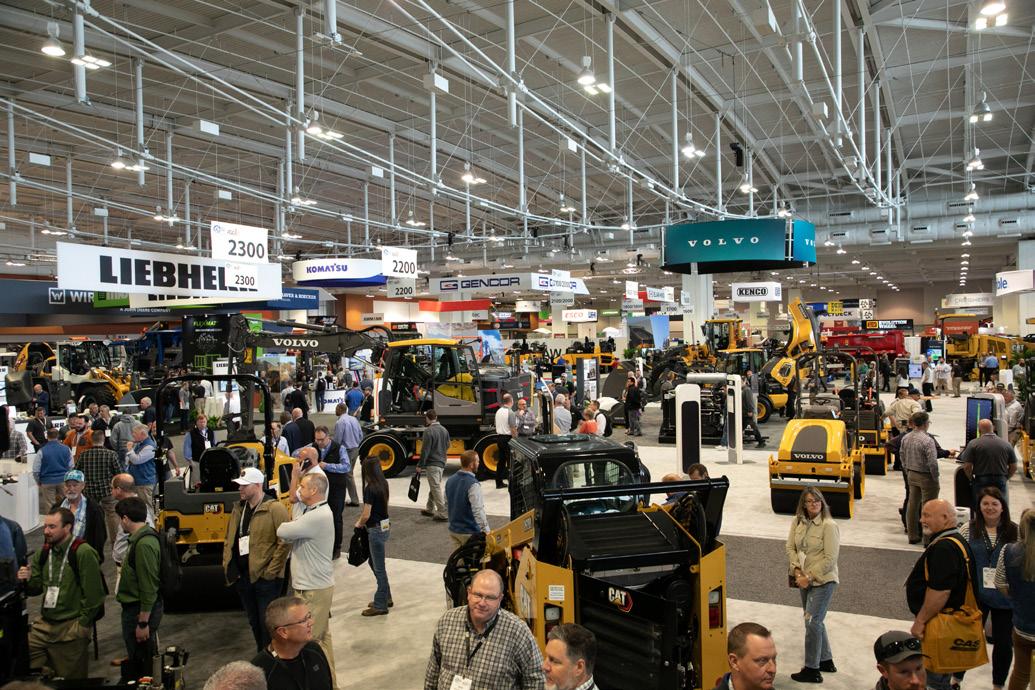
BREAKING RECORDS, SHATTERING EXPECTATIONS AT WORLD OF ASPHALT
A lot can happen in three years and World of Asphalt 2022 proved that you can’t stop innovation and you can’t stop an industry ready to work. www.ForConstructionPros. com/22158869
VIDEO: CATERPILLAR 8-FT. PAVERS FILL GAP IN ASPHALT MARKET
The all new line of Caterpillar pavers are a fit for urban streets, parking lots, rural roads and other small to intermediate-type applications.
SEE VIDEO: www.ForConstructionPros.com/22144240
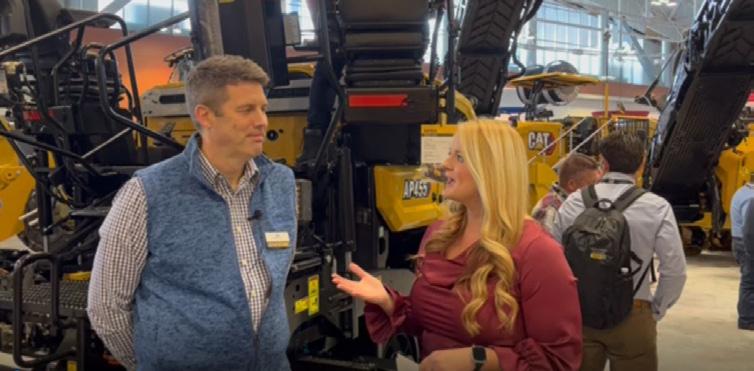
PODCAST: ENGINE TECHNOLOGY ADAPTING TO CHANGING REGULATIONS & USER NEEDS
Briggs & Stratton’s Vanguard 400 EFI/ETC engine features chokeless starting for a simplified user experience when firing up the engine and is operated without a battery.
SEE VIDEO: www.ForConstructionPros.com/22118970

WHAT YOU’LL FIND ONLINE
➊ All the latest news impacting the construction industry ➋ Exclusive articles on equipment, business management, safety and more ➌ New Product Directory hosting over 19,000 products ➍ Video Network with 1,000s of videos covering equipment, industry trends, applications and more ➎ Podcasts on equipment, technology, trending topics and more ➏ Profit Matters channel to help build profits in your construction business ➐ Blogs by the industry’s leading construction editors ➑ Current issues from five of the nation’s top construction industry publications ➒ AND MUCH MORE...

Construction Industry Has More Pain to Work Through

The current environment requires paying even closer attention to your balance sheet to ensure cash flow.
Garry Bartecki is the managing member of GB Financial Services LLP and a consultant to the Independent Equipment Dealers Association. He can be reached at (708) 347-9109 or gbartecki@comcast.net.
Iwas hoping that by this time I would have some good news to share with you. Stabilizing prices along with more available and attainable supplies. Minor increases in interest rates. Lower oil prices. All of which would bring us back to “business as usual” or at least point in that direction. This is normally how recessions work.
Unfortunately, these assumptions may not be realistic at this time because of the serious supply chain issues caused by the scary activities taking place in Europe. Then, add in the reactivated COVID woes once again closing down China and we wind up with some very serious issues that could impact your business.
In other words, our normal business cycles are not acting as expected which, of course, requires corporate management to spend more time managing costs and cash flow.
What we are hearing now is that inflation is here to stay. To reduce inflation, the Feds will increase interest rates, which eventually slows business down to the point inflation moderates and reverts back to the 2% Wall Street likes to see. This scenario represents our standard cycle – one that most business leaders have contended successfully with in the past.

If only we could keep things simple. But, under current conditions you cannot. World events will stretch out this economic chaos for at least another 24 months, mostly because our material cycles will not react in a normal manner, even though demand for products and services is falling.
They call this economic event Stagflation. Some of you have been through a Stagflation cycle before. But most of you have not had the privilege to do so, and may lack the experience to deal with it, which is tough to do.
STAGFLATION RISKS
Stagflation occurs when the economy is slowing (less sales) but pricing keeps rising (higher costs). I know, it does not make sense, but this is what happens when markets for key costs are unable to adjust at the same rate the economy is constricting.
So, what do we do about it? First, we do some homework to see how these types of cycles work, and then review the materials you purchase to run your business. Next, you determine how these types of events will impact suppliers, as well as customers. Then, you ask yourself a question, “If this happens in my segment of the construction industry, how will I produce adequate cash flow to pay my bills and have something left over for debt service and shareholders?” If you are already operating on slim margins because of COVID, you probably have little room to work with.
Think about it:
˜ Sales slowing ˜ Costs still increasing ˜ Interest costs higher
What I see is: ˜ Lower cash balance ˜ Accounts receivable higher than usual ˜ Inventories increasing instead of decreasing ˜ Accounts payable higher than usual ˜ Bank loan covenants in jeopardy ˜ Debt-to-equity ratios going higher ˜ Customers unwilling to accept bids with these higher cost figures
BALANCE SHEET MANAGEMENT REQUIRED
Using our standard inflation cycle, you may think you have things figured out, but Stagflation is something new requiring more capital to maintain your current level of business. If you find yourself in this situation, or feel you will be sooner rather than later, you should spend some time managing your balance sheet.
Some things to do: ˜ Get the management team on board. Make sure they understand what is happening. ˜ Rethink your 2022-23 business plan. Can you absorb the cost hits and make it up with additional business? ˜ Identify expenses or services you should shut down because they are not generating adequate returns. ˜ Prepare a list of potential changes in order of priority. ˜ Review all contracts with customers and vendors. Offer up changes as necessary. ˜ Mark up the cost increase properly to maintain cash flow. ˜ Prepare a running cash flow projection and compare to actual as the year progresses. ˜ Get the billing out more often to speed up collections.
If we get lucky, we may avoid this once-in-a-lifetime event and settle back into a normal business cycle. But I thought that it is important for you to be aware of what may be in the offing. Best to be ahead in the game as opposed to coming in last.
I promise next month we will get back to more upbeat topics. But until then be aware of a situation where you find sales slowing without a corresponding reduction in cost.
MAKE SURE INFRASTRUCTURE INVESTMENT HAPPENS
One last comment on the Infrastructure bill. Nomi Prins, an experienced banker, attended the Federal Open Market Committee in DC, and in the course of that meeting, had a chance to interview the House and Senate staffers about the infrastructure bill. Surprise, surprise, both sides supported the bill. But at the same time both sides were extremely worried that the bulk of the funds would somehow get siphoned off with only a small percentage of the bill actually paying for the projects it is supposed to cover.
This is where you come in. I suggest you make sure that funds earmarked for your area do in fact show up to generate the work they are supposed to cover. Let your elected officials know you are watching. ET
201 N. Main Street, 5th Floor Fort Atkinson, Wisconsin 53538 (800) 538-5544 www.ACBusinessMedia.com
Publication Staff
Publisher SEAN DUNPHY, sdunphy@ACBusinessMedia.com Editor BECKY SCHULTZ, bschultz@ACBusinessMedia.com Senior Field Editor CURT BENNINK, cbennink@ACBusinessMedia.com Contributing Writers GARRY BARTECKI, NATHAN MEDCALF Art Director DAVE HAGLUND Senior Production Manager CINDY RUSCH Audience Development Manager ANGELA FRANKS Advertising Sales (800) 538-5544
SEAN DUNPHY; NIKKI LAWSON; KRIS FLITCROFT; TADASHI SOMA
ForConstructionPros.com
Editor-in-Chief WAYNE GRAYSON Editor LARRY STEWART
AC Business Media
Chief Executive Officer.......................RON SPINK Chief Financial Officer............. JOANN BREUCHEL Chief Digital Officer ...................KRIS HEINEMAN Chief Revenue Officer ............... AMY SCHWANDT Brand Director Construction .........SEAN DUNPHY VP, Operations & IT ...................... NICK RAETHER VP, Audience Development ..........RONDA HUGHES Director, Demand Generation & Education ..................................... JIM BAGAN General Manager – Online & Marketing Services.......BETHANY CHAMBERS Content Director........................ MARINA MAYER
Change of Address & Subscriptions
PO Box 3605, Northbrook, IL 60065-3605, Phone: (877) 201-3915 • Fax: (847) 291-4816 circ.EquipmentToday@omeda.com
List Rental
Bart Piccirillo, Sr. Account Manager, Data Axle Phone: (518) 339-4511 bart.piccirillo@data-axle.com
Reprints
Reprints — For reprints and licensing please contact Sean Dunphy at 920-542-1252 sdunphy@acbusinessmedia.com
Published and copyrighted 2022 by AC Business Media Equipment Today makes every effort to report manufacturers’ product news accurately, but is not responsible for validity of news claims. All rights reserved. No part of this publication may be reproduced or transmitted in any form or by any means, electronic or mechanical, including photocopy, recording or any information storage or retrieval system, without written permission from the publisher. SUBSCRIPTION POLICY: Individual subscriptions are available without charge in the U.S. and Canada to management, engineering, supervisory, equipment maintenance and other personnel who have buying influence in the construction equipment industry. Subscribe online at www.ForConstructionPros.com. Publisher reserves the right to reject non-qualified subscribers.
One year subscription to non-qualified individuals: U.S. $50; Canada/Mexico $70; all other countries $100 (payable in U.S. funds, drawn on U.S. bank). Single copies available (prepaid only) $10.00 each (U.S., Canada & Mexico), $15.00 each (International). For change of address or subscription information call (847) 559-7598 or fax (847) 291-4816. Equipment Today (USPS 369-290, ISSN 0891-141X) is published is published 12x with issues of January, February, March, April, May, June, July, August, September, October, November and December by AC Business Media, 201 N. Main Street, 5th Fl., Fort Atkinson, WI 53538. Periodicals postage paid at Fort Atkinson, WI, and additional entry offices. POSTMASTER: Please send change of address to Equipment Today, PO Box 3605, Northbrook, IL 60065-3605. Printed in the USA.
Canada Post PM40612608. Return Undeliverable Canadian Addresses to: Equipment Today, PO Box 25542, London, ON N6C 6B2.
Vol. 58 No. 4 May 2022



